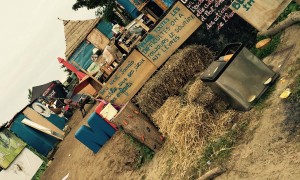It’s now estimated that between 4,000 and 6,000 people are living in the Calais refugee camp, a place now widely referred to in media circles as ‘The Jungle’.
But this particular moniker that doesn’t rest well with most volunteers who’ve travelled to Northern France to assist at a camp which has come to symbolise this enormous humanitarian crisis.
Among those volunteers is Waterford artist and former café proprietor Aoife Hanrahan (33, The Mall), who, along with Waterford-based paediatric nurse Sophie Rowan (and 50 other Irish citizens) spent a week in the camp from October 1st to 8th.
“Nothing could really have prepared me for what I saw once we arrived there,” said Aoife, who is already planning her second trip to Calais.
“My visual conception beforehand was nothing like the reality of I witnessed once we set foot inside the camp.
“We arrived on a dry, sunny day, and the ground beneath us was quite dusty. But the first thing that hit me was the smell from the campfires. The authorities haven’t been emptying the skips in the camp with a huge level of regularity – the skips were overflowing – so the only way that the refugees can only control the waste levels within the camp is to burn the excess themselves. And those fires created a heavy, heavy toxic smell. And that smell, coupled with the overflowing skips just left me thinking ‘Oh my God, what is this’ And the noise, I wasn’t prepared for how noisy it was.”
Aoife continued: “Refuge, that very word means to find somewhere safe, and that word kept running through my head, all the while I was there and ever since I got back to Waterford. But let me tell you, that transient camp in Calais is no refuge for anyone near those fences – it’s like a modern day concentration camp as far as I’m concerned. It’s just horrendous.”
Her eyes welling with tears, Aoife referenced catching sight of a dog in a kennel on board the ferry returning to Rosslare (from Cherbourg) at the end of her week in Calais.
“The puppy was caged and he was howling and it just brought me straight back to the camp, because that’s the perspective that I had for these poor people. For all the world, the people we met are caged at that camp, like animals. And I don’t understand the mentality of allowing people to live like this.
“We met Syrians, Sudanese, Kurds, Pakistanis, Eriterans and Afghans; the great majority of people on the camp being women and children, and they were so welcoming, so friendly. There was no animosity at all. They knew that we were there to help them, and they in turn helped us.
“We met doctors, builders, architects, musicians, artists, people just like me and you – while €18 million can be spent by the French and British Governments in a fence near the Euro Tunnel? And these people have been left there to fend for themselves and they have absolutely nothing.
“The running water in the camp is actually making them sick; there’s a high level of E coli in the supply and the meal provided to them every day: oh my goodness, you wouldn’t give it to a dog at home. What I saw discarded in one such food container was like something out of Dickens. And this is just an hour and a half away from where we live, with all our comforts. It’s head spinning, it really is.”
Estimating that the camp was “roughly the size of three large football pitches”, Aoife offered first aid while Sophie put her nursing expertise to incredible use, with the Irish medical team seeing over 1,000 patients inside a week. Four days, in fact. That’s right, Four days.
“We’re both going back, Sophie and I,” she added. “We were busy while we were there, but that was the whole point of going there: to help as many people as we could in the time we had available. We distributed clothing, helped build a medical centre, assisted at a women’s medical shelter and helped to build a giant stove called ‘Bender’, where women and children go when it gets very cold. We picked up a lot of litter and the refugees helped us with that too, as they did in so many other ways. And this camp has been here for 12 years – I don’t know how many Irish people may have known that. It’s grown in prominence because of the bottleneck the camp has become, at the tip of France, with the British coast in full view.
“And to see how the French police have dealt with the refugees – it makes me very angry and very, very sad. The camp has been tear gassed; we treated people who’d been pepper sprayed, to know that police dogs are being unmuzzled and sent up the Euro Tunnel after those making a run for it. And this is happening in 2015. How can this be?”
But Aoife Hanrahan still saw hope amidst the sadness. “There was hope in the eyes of the refugees; you could sense their hope when you’re in their company. These are people who, in many cases, have nothing left to fight for but their freedom, and the hope that comes with freedom.
As Andy Dufresne (Tim Robbins) memorably put it in ‘The Shawshank Redemption: “Hope is a good thing, maybe the best of things, and no good thing ever dies.” Aoife Hanrahan shall return to Calais next month. Hope shall meet hope again. And that’s no bad thing at all.


